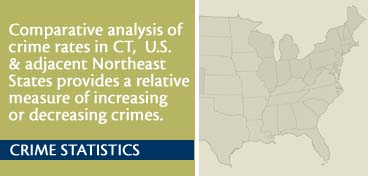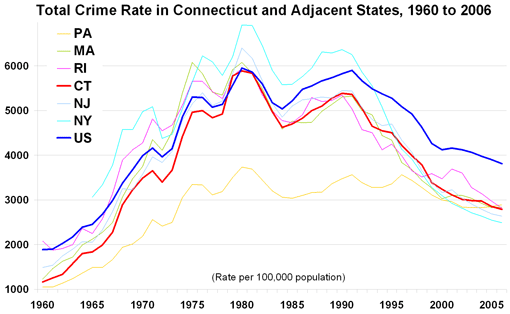| Research, Analysis & Evaluation |
CRIME REPORTS |
|
[$XQ=384746$] | |||||
 |
| |||||
| CRIME REPORTS | |||
|
The reports below are available in Adobe PDF format. To view these documents either get the Adobe Reader OR use the Adobe PDF Converter. Excerpt from the "Comparative Analysis of Crime Rates... 1960 to 2006" publication listed above...
The FBI’s Uniform Crime Reporting (UCR) Program defines total crime rate as an index for gauging fluctuations in the overall volume and rate of crime. Also known as the Crime Index, these seven offenses included the violent crimes of murder, rape, robbery, and aggravated assault and the property crimes of burglary, larceny-theft, motor vehicle theft and arson.
 Connecticut’s total crime rate has patterned similarly to that of the U.S. and other adjacent Northeast States over the past 45 years, but typically at a lower rate. Overall, the total crime rate for Connecticut in 2006 is the lowest it has been in 37 years, since prior to 1968. As with most other adjacent States, the total crime rate peaked in 1980 and again in 1990 with a steady decline to 2006.
| |||
| WHAT IS UNIFORM CRIME REPORTING (UCR) | ||
|
The FBI’s Uniform Crime Reporting (UCR) Program gathers offense data for violent and property crimes. Offenses that make up the Crime Index are Part I crimes—violent crimes of murder and non-negligent manslaughter, forcible rape, robbery, and aggravated assault; property crimes of burglary, larceny-theft, motor vehicle theft, and arson. In addition to reporting Part I offenses, law enforcement agencies provide monthly data to the UCR Program on persons arrested for all other crimes except traffic violations, police officers killed or assaulted and hate crimes (reported Quarterly).
In 2006, more than 17,500 city, county, college and university, state, tribal, and federal agencies voluntarily participated in the UCR Program. These agencies represented 94.2 percent of the Nation's population. For more information, see UCR Frequently Asked Questions.
|
| DATA COLLECTION METHODOLOGY | ||
|
Law enforcement agencies that participate, forward crime data through their State UCR Programs in 46 States and the District of Columbia. Local agencies without State UCR Programs submit crime statistics directly to the FBI. Many states have mandatory reporting requirements, and many State UCR Programs collect data beyond those typically called for by the national UCR Program to address crime problems specific to their particular jurisdictions.
Law enforcement agencies tabulate the number of Part I crimes brought to their attention based on records of all reports of crime received from victims, officers who discover infractions, or other sources, and submit them each month to the FBI either directly or through their State UCR Programs. | ||
| CONNECTICUT UCR PARTICIPATION | ||
|
Every month law enforcement agencies, and some colleges and universities throughout Connecticut submit UCR data to the DPS Crimes Analysis Unit. According to the Unit, there is 100% participation in the UCR Program over time.
The National Incident-Based Reporting System (NIBRS) is a second generation UCR system that went into effect in Connecticut in 1993. NIBRS collects and reports data on each incident, and allows reporting of one or more offenses for any one incident. Information in UCR is summary based, meaning that only the highest level offense in any one incident is reported. Consequently, NIBRS data provides considerable more detail about an incident, and yields richer and more meaningful information than those produced by the summary UCR system. In Connecticut, there are169 municipalities with 92 separate local Police Departments (PD) which cover 85% of the State’s population. Among the 92 local PD, 66 utilize NIBRS and 26 utilize UCR. The Connecticut State Police use the NIBRS system and provide police services for another 81 Connecticut towns and places (or 15% of the State’s population). In addition, there are 7 campus police departments also reporting, 5 of which use NIBRS and 2 that use the summary UCR system. The State Capitol Police utilize the NIBRS system. | ||
| FBI DATA CAUTIONS | ||
|
The FBI cautions data users of Crime in the United States against comparing statistical data of cities, counties, metropolitan areas, states, colleges or universities solely on the basis on their population coverage or student enrollment. In addition, the FBI cautions data users to exercise care in making any direct comparison between data in this publication and those in prior issues, because of differing levels of participation from year to year and reporting problems that require the FBI to estimate crime counts for certain contributors, the data may not be comparable from year to year. Some factors that are known to affect the volume and type of crime occurring from place to place are:
|


